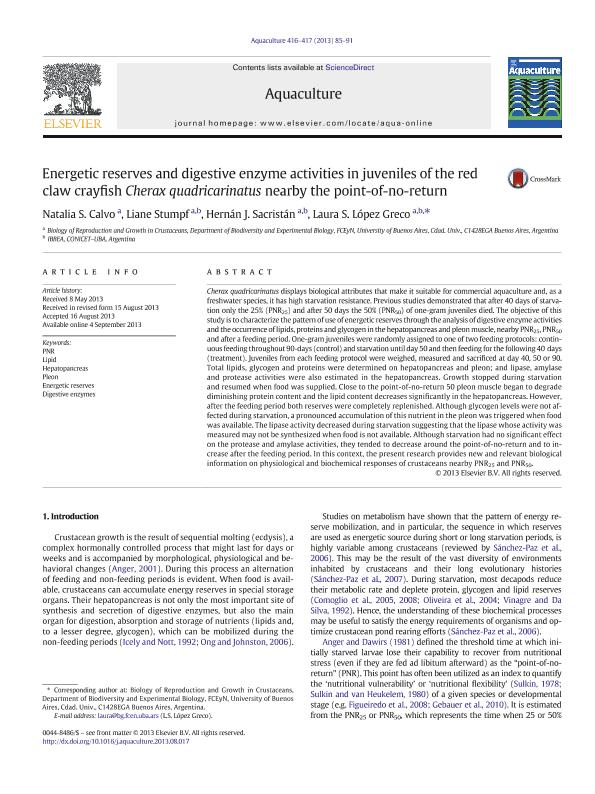Mostrar el registro sencillo del ítem
dc.contributor.author
Calvo, Natalia Soledad

dc.contributor.author
Stumpf, Liane

dc.contributor.author
Sacristán, Hernán Javier

dc.contributor.author
Lopez, Laura Susana

dc.date.available
2017-01-18T15:19:56Z
dc.date.issued
2013-08
dc.identifier.citation
Calvo, Natalia Soledad; Stumpf, Liane; Sacristán, Hernán Javier; Lopez, Laura Susana; Energetic reserves and digestive enzyme activities in juveniles of the red claw crayfish Cherax quadricarinatus nearby the point-of-no-return; Elsevier Science; Aquaculture; 416-417; 8-2013; 85-91
dc.identifier.issn
0044-8486
dc.identifier.uri
http://hdl.handle.net/11336/11547
dc.description.abstract
Cherax quadricarinatus displays biological attributes that make it suitable for commercial aquaculture and, as a freshwater species, it has high starvation resistance. Previous studies demonstrated that after 40 days of starvation only the 25% (PNR25) and after 50 days the 50% (PNR50) of one-gram juveniles died. The objective of this study is to characterize the pattern of use of energetic reserves, through the analysis of digestive enzyme activities and the occurrence of lipids, proteins and glycogen in the hepatopancreas and pleon muscle, nearby PNR25, PNR50 and after a feeding period. One-gram juveniles were randomly assigned to one of two feeding protocols: continuous feeding throughout 90-day (Control) and starvation until day 50 and then feeding for the following 40 days (Treatment). Juveniles from each feeding protocol were weighed, measured and sacrificed at day 40, 50 or 90. Total lipids, glycogen and proteins were determined on hepatopancreas and pleon; and lipase, amylase and protease activities were also estimated in the hepatopancreas. Growth stopped during starvation and resumed when food was supplied. Close to the point-of-no-return 50 pleon muscle began to degrade diminishing protein content and the lipid content decrease significantly in the hepatopancreas. However, after the feeding period both reserves were completely replenished. Although glycogen levels were not affected during starvation, a pronounced accumulation of this nutrient in the pleon was triggered when food was available. The lipase activity decreased during starvation suggesting that the lipase whose activity was measured may not be synthesized when food is not available. Although starvation had no a significant effect on the protease and amylase activities, they tended to decrease around the point-of-no-return and to increase after the feeding period. In this context, the present research provides new and relevant biological information on physiological and biochemical responses of crustaceans nearby PNR25 and PNR50.
dc.format
application/pdf
dc.language.iso
eng
dc.publisher
Elsevier Science

dc.rights
info:eu-repo/semantics/openAccess
dc.rights.uri
https://creativecommons.org/licenses/by-nc-nd/2.5/ar/
dc.subject
Pnr
dc.subject
Lipid
dc.subject
Hepatopancreas
dc.subject
Pleon
dc.subject
Energetic Reserves
dc.subject
Digestive Enzymes
dc.subject.classification
Otros Tópicos Biológicos

dc.subject.classification
Ciencias Biológicas

dc.subject.classification
CIENCIAS NATURALES Y EXACTAS

dc.title
Energetic reserves and digestive enzyme activities in juveniles of the red claw crayfish Cherax quadricarinatus nearby the point-of-no-return
dc.type
info:eu-repo/semantics/article
dc.type
info:ar-repo/semantics/artículo
dc.type
info:eu-repo/semantics/publishedVersion
dc.date.updated
2016-12-12T21:07:10Z
dc.journal.volume
416-417
dc.journal.pagination
85-91
dc.journal.pais
Países Bajos

dc.journal.ciudad
Amsterdam
dc.description.fil
Fil: Calvo, Natalia Soledad. Universidad de Buenos Aires. Facultad de Cs.exactas y Naturales. Departamento de Biodiversidad y Biologia Experimental. Laboratorio de Biologia de la Reproduccion y Crecimiento de Crustaceos Decapodos; Argentina
dc.description.fil
Fil: Stumpf, Liane. Universidad de Buenos Aires. Facultad de Cs.exactas y Naturales. Departamento de Biodiversidad y Biologia Experimental. Laboratorio de Biologia de la Reproduccion y Crecimiento de Crustaceos Decapodos; Argentina. Consejo Nacional de Investigaciones Cientificas y Tecnicas. Oficina de Coordinacion Administrativa Ciudad Universitaria. Instituto de Biodiversidad y Biologia Experimental y Aplicada; Argentina
dc.description.fil
Fil: Sacristán, Hernán Javier. Universidad de Buenos Aires. Facultad de Cs.exactas y Naturales. Departamento de Biodiversidad y Biologia Experimental. Laboratorio de Biologia de la Reproduccion y Crecimiento de Crustaceos Decapodos; Argentina. Consejo Nacional de Investigaciones Cientificas y Tecnicas. Oficina de Coordinacion Administrativa Ciudad Universitaria. Instituto de Biodiversidad y Biologia Experimental y Aplicada; Argentina
dc.description.fil
Fil: Lopez, Laura Susana. Universidad de Buenos Aires. Facultad de Cs.exactas y Naturales. Departamento de Biodiversidad y Biologia Experimental. Laboratorio de Biologia de la Reproduccion y Crecimiento de Crustaceos Decapodos; Argentina. Consejo Nacional de Investigaciones Cientificas y Tecnicas. Oficina de Coordinacion Administrativa Ciudad Universitaria. Instituto de Biodiversidad y Biologia Experimental y Aplicada; Argentina
dc.journal.title
Aquaculture

dc.relation.alternativeid
info:eu-repo/semantics/altIdentifier/url/http://www.sciencedirect.com/science/article/pii/S0044848613004158
dc.relation.alternativeid
info:eu-repo/semantics/altIdentifier/doi/http://dx.doi.org/10.1016/j.aquaculture.2013.08.017
Archivos asociados
